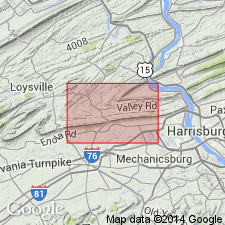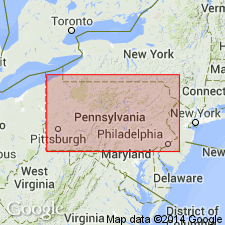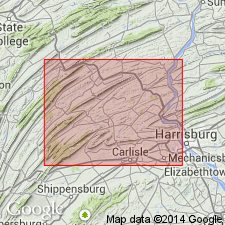
- Usage in publication:
-
- Duncannon Member
- Modifications:
-
- Named
- Dominant lithology:
-
- Sandstone
- Siltstone
- Shale
- AAPG geologic province:
-
- Appalachian basin
Summary:
Above Clarks Ferry Member in Peters Mountain section is approximately 1,200 ft of interbedded red and nonred strata. Dyson (1963) subdivided these 1,200 ft into two unnamed members, Upper Redbed Member and Upper Sandstone Member. Because these two units are not mappable over a sufficiently wide region, they are recombined on present map and herein named Duncannon Member of Catskill Formation. Lower part of member consists of about 600 ft of red siltstone, shale, and fine-grained sandstone with six interbedded gray sandstone units varying in thickness from 5 to 36 ft. Lower part overlain by group of gray, in part pebbly, medium- to coarse-grained sandstone units separated by thinner units of grayish-red siltstone and shale. Aggregate thickness of these strata 585 ft. Underlies Spechty Kopf Member of Pocono Formation. Age is Late Devonian.
Source: GNU records (USGS DDS-6; Reston GNULEX).

- Usage in publication:
-
- Duncannon Member
- Modifications:
-
- Overview
- AAPG geologic province:
-
- Appalachian basin
Summary:
Author's purpose is to describe in detail the sedimentology of the Sherman Creek, Clarks Ferry and Duncannon Members of the upper part of the Catskill Formation as seen in three outcrops along Rte 322 in south-central PA. Outcrops are at Second Mountain, Peters Mountain, and Buffalo Mountain. All three members are composed of sandstone bodies and sandstone-mudstone interbeds and are recognized in part on the basis of the varying ratios of the two lithofacies associations. The Sherman Creek and Duncannon Members are composed of approximately equal amounts of sandstone and mudstone in the study area, while the Clarks Ferry is dominated by sandstone and is not as widespread. These three members are assigned to the alluvial plain depositional environment. Duncannon Member at Second Mountain is 405 m thick and composition is only 23 percent sandstone. At Peters Mountain thickness increases to 398 m and sandstone percentage to 55. At Buffalo Mountain Duncannon composes the entire Catskill outcrop and is 85 m thick and 45 percent sandstone.
Source: GNU records (USGS DDS-6; Reston GNULEX).

- Usage in publication:
-
- Duncannon Member
- Modifications:
-
- Overview
- AAPG geologic province:
-
- Appalachian basin
Summary:
Buffalo Mountain paleosol is very representative of a typical paleosol in the Duncannon Member of the Catskill Formation. The Duncannon exhibits repeated stacking of 5- to 10-m thick fining-upward sequences that consist of erosive-based, non-red, cross-stratified, medium- to coarse-grained channel sandstone; red-brown, ripple cross-laminated to parallel-laminated, very fine- to fine-grained sandstone; red-gray silty claystone, commonly with paleosol features. The 5-m thickness of the paleosol interval suggests that it probably is composed of several different paleosols, formed by repeated episodes of floodplain aggradation alternating with pedogenesis. Rhizoliths and calcareous nodules occur just above the laminated siltstone at the base of the Buffalo Mountain, indicating rooting during early stages of soil formation. Above the nodules are 3 m of clayshale, characterized by pedogenic slickensides. Age of the Duncannon and its Buffalo Mountain paleosol is Late Devonian.
Source: GNU records (USGS DDS-6; Reston GNULEX).
For more information, please contact Nancy Stamm, Geologic Names Committee Secretary.
Asterisk (*) indicates published by U.S. Geological Survey authors.
"No current usage" (†) implies that a name has been abandoned or has fallen into disuse. Former usage and, if known, replacement name given in parentheses ( ).
Slash (/) indicates name conflicts with nomenclatural guidelines (CSN, 1933; ACSN, 1961, 1970; NACSN, 1983, 2005, 2021). May be explained within brackets ([ ]).

